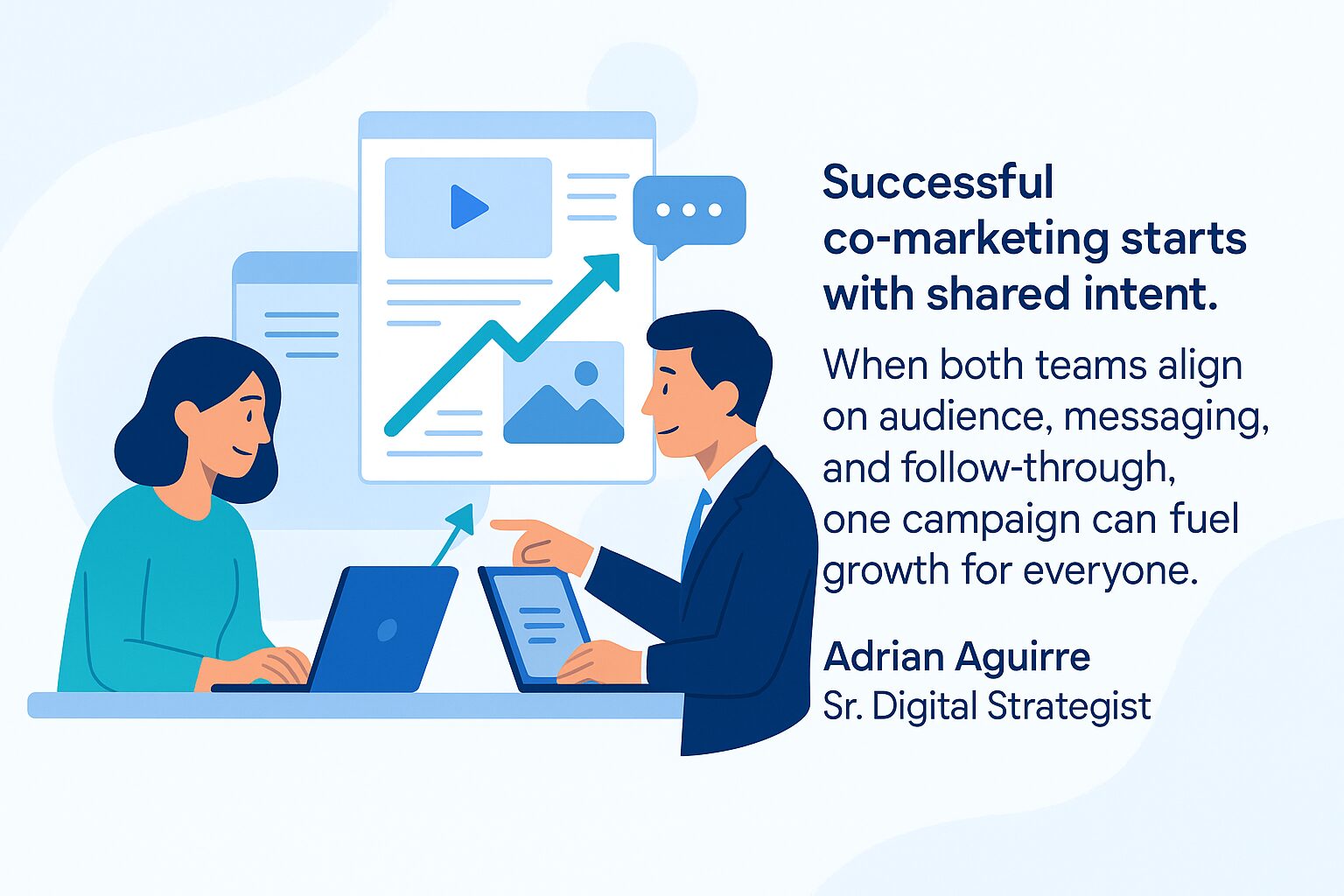TL;DR:
- Co-marketing allows agencies and partners to expand reach, share credibility, and lower marketing costs.
- The best collaborations begin with aligned audiences and clear, shared goals.
- Strong communication and content planning keep both brands visible and consistent.
- Track shared performance metrics to prove ROI and strengthen the relationship.
- The right partnership can turn one campaign into lasting revenue growth for both teams.
Growing an agency or consultancy often comes down to finding the right collaborations. You already share clients with other firms—design agencies with developers, marketers with brand strategists, consultants with technology partners. Each brings unique strengths. The challenge is how to combine those strengths into campaigns that drive growth for both sides.
That’s where co-marketing comes in.
When executed thoughtfully, co-marketing turns partnership into a lead-generating engine. It helps both teams reach new audiences, strengthen credibility, and deliver more value to clients without doubling the workload.
But successful co-marketing doesn’t happen by accident. It requires strategy, transparency, and shared investment in results.
The Benefits of Co-Marketing for Growth
Before diving into logistics, it’s worth understanding what makes co-marketing such a powerful growth lever.
- Expanded Reach. You instantly gain exposure to your partner’s audience. Joint webinars, blog posts, or downloadable guides introduce your expertise to prospects who might never have found you otherwise.
- Shared Credibility. When two trusted brands collaborate, each benefits from the other’s reputation. Clients see strength in collaboration, not competition.
- Lower Marketing Costs. Co-marketing allows you to share the budget for design, content, ads, and promotion while still reaping the full benefit of exposure.
- Deeper Relationships. Joint campaigns help strengthen referral pipelines and build long-term partnership trust. The more you work together, the more confidently you can refer each other’s services.
- New Lead Sources. A shared campaign creates opportunities for both parties to collect, nurture, and convert leads using coordinated lead generation tactics.

Step 1: Choose the Right Partner
Not every partner is a good fit for co-marketing. The right collaborator should:
- Serve a similar audience but offer complementary services
- Share your values around client quality and delivery
- Have a solid brand reputation and marketing capability
- Be equally committed to measuring success
For example, a creative agency might collaborate with a firm that offers web design and development, or a digital marketer might partner with a data analytics company. When audiences align and services complement each other, campaigns feel seamless to potential clients.
Step 2: Define Shared Goals and Responsibilities
Before creating anything, align on what success looks like. Ask:
- What’s the primary goal—awareness, lead generation, or pipeline acceleration?
- Who owns what tasks—content creation, design, promotion, reporting?
- How will leads be shared and followed up on?
Document everything in a shared plan or agreement. Clarity on roles prevents confusion once campaigns are live.
Step 3: Choose the Right Co-Marketing Format
There are many ways to execute a joint campaign. The key is to select formats that fit both your audiences and your available resources.
Consider:
- Webinars or Virtual Events: Co-hosted sessions showcasing both teams’ expertise.
- Co-Branded Content: Blog posts, eBooks, or infographics that educate shared audiences.
- Podcast Appearances: Swap guest spots or create a short series together.
- Social Media Campaigns: Coordinate messaging and cross-promotions.
- Client Case Studies: Tell the story of a successful shared project and highlight each team’s contribution.
Each of these formats builds visibility and trust across both networks, creating natural growth opportunities.
Step 4: Promote Together, Consistently
A co-marketing effort only works if both partners commit to promoting it equally. Align on timelines and tactics for:
- Email marketing sequences
- Social media announcements
- Paid amplification through paid media management
- Website placement or blog features
- Direct outreach to shared client lists
Use a shared editorial calendar to stay aligned and ensure neither side goes quiet halfway through the campaign.
Step 5: Measure Results and Celebrate Wins
The final step is accountability. Both partners should review key metrics and compare outcomes. Consider tracking:
- Website visits or engagement spikes from co-branded content
- New leads or inquiries from shared campaigns
- Conversion rate optimization results on specific landing pages
- Social engagement and content reach
- ROI of joint advertising or event spend
Share results transparently and discuss what worked, what didn’t, and how to improve next time. Celebrating success strengthens the partnership and lays the groundwork for future campaigns.
How 3 Media Web Can Help
At 3 Media Web, we help agencies and marketing partners create and optimize digital ecosystems that support mutual growth. From strategy and web design and development to ongoing website support and collaborative SEO campaigns, we build the infrastructure that makes co-marketing partnerships run smoothly.
We act as an extension of your team—providing the strategy, execution, and analytics that help both sides deliver measurable results.
